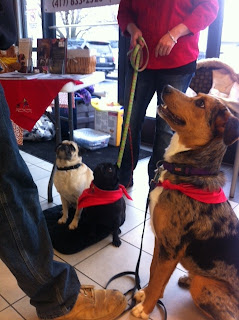The comment that I hear the most from students in class is “My dog does this at home why won’t he do it here?” When training your dog you will find that they can do what you have taught them very well in the areas that they have worked the most in like your home and the training facility. In order to get your dog to do the behavior in every place that you ask you must practice in all kinds of places under all kinds of distractions. We call this “taking it on the road”.
There are many little parts of a behavior that fit together to make the whole. For example: A sit seems fairly easy but if you break it down into all the things that the dog thinks sit means it can become complicated. To the dog the act of putting his bottom on the ground includes the cue you give, his position in relation to you, how fast he is required to sit, and how long he holds the sit. Just changing the environment can affect all of these things.
The cue should be consistent and clear. I teach a verbal as well as a hand signal. If you give both at the same time the dog is really only responding to one. Pay attention to how you change your cues of you are out of the normal training areas or with other people.
The position of the dog should be considered and consciously trained. Heel position with the dog on the left is the conventional starting place for many behaviors. But the dog can sit close on your left, right, or between your feet. Your dog can also sit facing you, facing out, or at a distance.
If the dog is not required to sit quickly each time he is reinforced you will end up with slow or halfhearted sits. Be consistent with the speed of the sit that you will reinforce and you will get consistent fast responses. If he doesn't perform the behavior that was cued he should not be reinforced. There is a consequence for his failure to respond.
Many dogs have rubber band sits. They sit then pop up as soon as the reinforcement is delivered. You need to build duration with the behavior so that they understand they must hold that position.
When you change the environment you add many distractions that your dog might rather pay attention to instead of you. Most of dog training is getting and keeping your dog’s focus. Once you have their attention the individual behaviors are easy to get. But if your dog is too busy looking away from you there won’t be a response to the cue you gave.
To “take it on the road” you need to take your dog with you when you are out and about and get them out of the car and do a quick training session. Don’t get wrapped up in going to dog places. Go to the bank, kids school, down the road, or a friend’s house.
One of the classes we start in March is called Dogs About Town. We will meet at a different place every week and proof the behaviors with lots of distractions. Can your dog come when called past the duck pond? How about stay while kids run around them? Can he settle at your feet while you enjoy a snack at a picnic table? Real life situations are what we train our dogs for. We are limited in what we can do with our dog if they only “do it perfectly at home.”

.JPG)
No comments:
Post a Comment